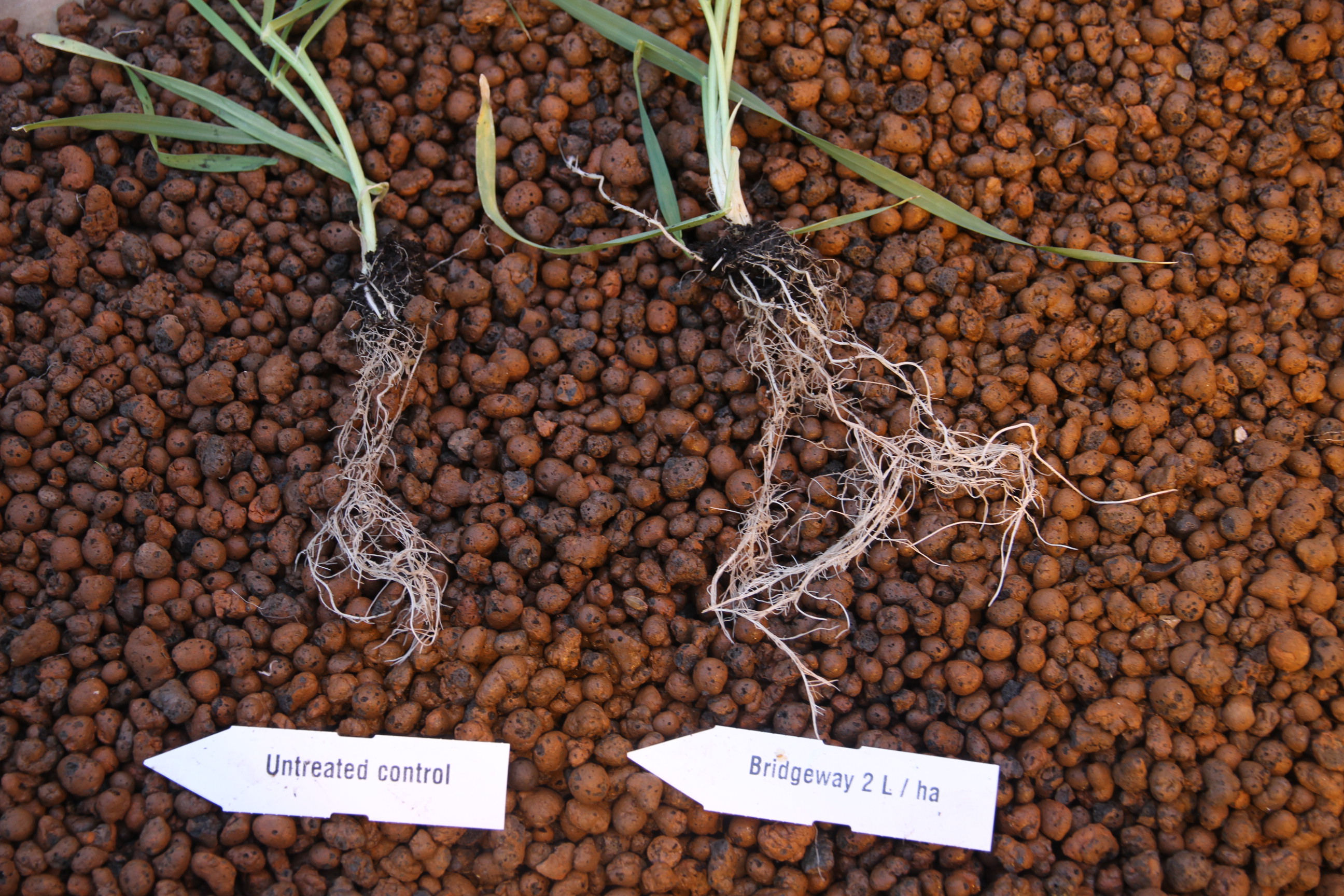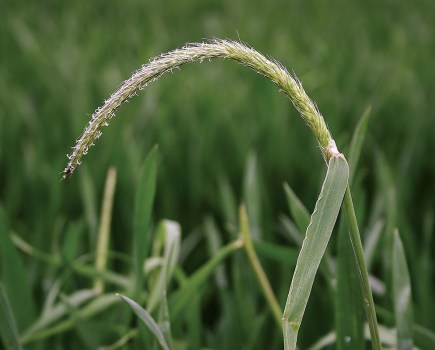CPM dives deeper into the role of some of the key amino acids and organic N in plant health and crop development and finds out the latest research, where abiotic stress is enforced on plants and the effect of Bridgeway quantified.
The data suggest that growers are almost certain to get a benefit.
By Lucy de la Pasture
If there’s one thing that can be guaranteed in the life of a crop, it’s that it will experience stress at some point caused by environmental factors or from attack by pests and diseases. The effect on the productivity very much depends on the degrees of stress and the crop’s ability to withstand it.
Building resilience into cropping systems is becoming increasingly important as a changing global climate leads to more severe frequent weather extremes, says Stuart Sutherland, technical manager at Interagro.
“The Met Office published a Climate Predictions Report in Dec 2018 and its findings are in-line with earlier projections that the UK can expect an increased chance of warmer, wetter winters and hotter, drier summers, along with an increase in the frequency and intensity of extremes moving forward.

Stuart Sutherland says we’re already experiencing more climate extremes so crops need to be more resilient.
“We’re already experiencing the demands these climate extremes place on crops,” he says, highlighting the 2018 season as a prime example. “This means crops will need to be more resilient to a wider range of conditions than we’ve been used to.”
One of the ways growers can help crops survive environmental (abiotic) stresses better is to supply them with Bridgeway, which contains all the 18 L-amino acids that plants need for healthy growth and development, as well as readily available organic nitrogen, recommends Stuart.
To understand how amino acids can help alleviate abiotic stress in this way, Stuart explains the metabolic role of different amino acids within the plant during its life.
“During periods of abiotic stress, plants increase production of L-proline, primarily to help strengthen cell walls and their resistance to weather extremes. This reduces the effect of the stress and speeds up the plant’s recovery time,” he explains.
It’s an effect that was clearly seen in Malcolm Gemmill’s wheat at Dunmow in Essex last season. “We tried Bridgeway at 1.0 l/ha at T1 on some second wheat KWS Zyatt. The crop came under severe drought pressure later in the season, and although we didn’t see any visual differences in season from applying the Bridgeway, we did see a 0.54 t/ha uplift in yield.
“With a ROI of over £80/ha, the Bridgeway more than paid for itself and there may be a place for it in stress situations where it can help turn crops around,” he comments.
Amino acids play crucial roles in other metabolic processes, one of these being photosynthesis – the most important chemical process in plants where carbon dioxide, water and light energy are synthesized into sugars which the plant uses as an energy source.
“This process is highly dependent on the amino acids L-glycine and L-glutamic acid. Both amino acids are key components for the production of chlorophyll, a pigment which absorbs light energy for photosynthesis. Increasing the supply of these amino acids increases light absorption, which increases of the rate photosynthesis.”
It’s an effect Hutchinsons agronomist Robert Barker has observed in the field. “In spring cropping, I noticed an increase in green leaf area where we’d used Bridgeway early. This then required careful management and repeat applications since the larger crop canopy respired more, so needed more applications to maintain the yield effect.”
Certain amino acids help increase the availability of nutrients to plants, continues Stuart. “Some nutrients aren’t available to plants due to their molecular structure, ionic charge etc. The amino acids L-glycine and L-glutamic acid are able to bond with these nutrients, making them available to the plant. These amino acids are tiny molecules which allows them to easily move through cell membranes.
“Their ability to bind excess metals means they’re also able to reduce metal toxicity in plants,” he adds.
Frontier agronomist Steven Penrice recommended applying Bridgeway last year to a crop of winter oilseed rape with high yield potential in Scotland. “We wanted to release some of the stress the crop was under in the spring from the dry conditions, but we also wanted to use Bridgeway to maximise nutrient use within the plant and support the crop’s high yield potential.

Bridgeway gave very positive and statistically significant effects on plant growth, with larger effects consistently observed with root growth (+41%). Image is barley.
“We used 1.5 l/ha at early stem extension and again at green bud, with no visible signs seen in the crop thereafter. On harvest though, it was clear that the untreated tramlines were significantly lower yielding by up to 0.25t/ha. I look forward to seeing other ways Bridgeway can maximise yield potential going forward.”
Robert adds it’s important to remember Bridgeway isn’t a micronutrient. “Any deficiencies should be addressed throughout the season and these are separate to a Bridgeway programme.”
One of the fascinating roles of amino acids in plants is as precursors to hormones and growth factors, explains Stuart. “L-tryptophan is involved in rooting and is required in auxin synthesis for growth and development. L-methionine is a precursor to ethylene which stimulates ripening and L-arginine is a precursor to cytokinin production, which is a hormone involved in cell growth, auxiliary bud growth and leaf senescence.
“Pollination and fruit formation are some of the most important phases of crop development and are extremely energy intensive due to the very high levels of amino acids required.”
He highlights important amino acids at these growth stages are L-histidine, which helps with ripening; L-proline, which increases pollen fertility; L-lysine, L-methionine and L-glutamic acid, which all increase germination; and L-alanine, L-valine, and L-leucine, which improve fruit/grain quality.
Bridgeway also contains organic nitrogen, the most important nutrient for plant development. “It’s a major constituent of essential compounds such as chlorophyll, nucleic acid (DNA and RNA) and amino acids.”
The consequences of limited nitrogen supply are all too well known to growers, and result in reduced leaf area, chlorophyll (yellowing of crop) and photosynthetic rate which add up to lower biomass and yields, comments Stuart.
“To support growth and development, sufficient N needs to be taken up and allocated to source and sink organs in the plant. Plants acquire N from nitrate and ammonium fertilisers, or it can be sourced from feeding the crop amino acids – as in Bridgeway. Feeding the crop Bridgeway at the critical stages of crop development not only provides the key amino acids the crop needs, it also offers a valuable N top-up,” he says.
Neil Cairns, farm manager and agronomist at Barfoots has integrated Bridgeway into their organic strategy on tender stem broccoli. “We applied the Bridgeway at three weeks and eight weeks post-planting, and again two weeks before harvest, each at a dose of 3.0 l/ha, with very pleasing results. Our crops look healthier with more green leaf area and we’re seeing a higher quality of crop at harvest.”
During reproductive growth, flowers and seeds represent the major N-sink. “Transport of N to newly developing flowers is a significant determinant for flower set, growth and abortion and it’s essential for proper development of male and female gametophytes. Since the application of nitrogen fertilisers to crops is limited, the additional boost from Bridgeway will be particularly useful, especially if the crop is deficient.”
So the theory behind supplementing crops with amino acids seems to stack up, but how beneficial is Bridgeway to plants under specific abiotic stresses? Dr Steve Rossall, University of Nottingham, is the man charged with finding out.
He designed tests to look at the effect of Bridgeway on early root and shoot growth in winter wheat (KWS Siskin) and spring barley (Concerto). Plants were treated with two rates of Bridgeway, 1.0 l/ha and 2.0 l/ha, at GS14 and the effects on root and shoot growth were determined 24 days after application.
Steve imposed low nutrient stress, achieved by feeding with a 10% rate of the standard feed; water stress, by irrigation with the standard feed every fourth day rather than daily or when the plants started to show drought symptoms; and heat stress, where plants were under standard feed and irrigation at a constant 30⁰C.
“Bridgeway gave very positive and statistically significant effects on plant growth, with larger effects consistently observed with root growth,” he comments. “Similar effects were seen with shoot growth, but the effects weren’t so big suggesting the driving parameter is enhanced rooting.
“Spring barley appeared to be more responsive than winter wheat to shoot growth, perhaps reflecting its faster growth,” suggests Steve.
With wheat, there was an indication that the enhanced root growth was greater when the plants were stressed, especially for water and high-temperature stress, yet the improvements were still very beneficial and statistically significant in non-stressed wheat.
Steve has put numerous biostimulants through their paces over the years using the same protocol and describes Bridgeway as ‘one of the better ones’ and ‘a benchmark product’.
“Even though the Bridgeway was applied in an ‘idealised’ way in these tests, the data suggests that growers are almost certain to get a benefit every year and will see a real benefit in stress years, particularly where plants are short of water in the establishment phase.
“There’s still more research to do but I believe the best returns will be from using Bridgeway in a programmed approach, integrated with existing agronomic practices,” he adds.
Robert aimed to do just this last season. “In cereals, I planned to use 2.0 l/ha at T2 and T3, but I had to top this up at flowering with a further 1.0 l/ha because conditions remained hot and dry. This season I believe the yield response was from maintaining the later applications,” he comments.
“My three-spray programme in a non-replicated split field trial, yielded 14t/ha treated compared with the farm standard of 12.5t/ha. So even on a high yielding site the benefit was seen.”
Stuart describes the results of Steve’s stress tests as ‘extremely exciting’. “The fact Bridgeway can increase early root growth in wheat and barley significantly, and by as much 40%, could be of huge benefit to crops during early crop establishment. Crops typically experience some sort of stress early on, particularly in the spring when soils can be dry and nutrients are locked up.
“The benefits of Bridgeway were even more dramatic when the crop was under nutrient, heat and water stress – all factors typically experienced by crops. Bridgeway’s ability to improve rooting by almost 50%, compared to the untreated controls, could really help crops cope better in the field.
“Building structure and root biomass early in the life of the crop will help the crop to be more resilient to environmental stresses. Topping up with Bridgeway later in the season will help to ensure the early benefits are captured in yield later on,” he adds.


How to use Bridgeway to best effect
Stuart recommends applying Bridgeway at 2.0 l/ha early in crop establishment (GS14 in wheat and barley) and follow up at the key stages of crop development when demand for amino acids is greatest to optimise plant health throughout the life of the crop.
“If crop stress is anticipated and Bridgeway hasn’t been applied within three weeks of that time, we would recommend applying Bridgeway, ideally ahead of the stress event or during if necessary,” he advises.
Robert Barker used Bridgeway last season due to the high levels of stress exerted on the crop from hot, dry weather. “I had previously trialled an amino acid product and seen information from Southern Europe where they’ve helped build or maintain yield under such conditions. My experience is they must be applied before the crop is stressed, having used Bridgeway in 2017 on a sand land crop under serious stress, it had no observable yield effect.
He intends to watch the weather closely in 2019. “If conditions look like they’ll stress the crop, then I would apply 1.0-2.0 l/ha Bridgeway to bridge the gap to better conditions. But be prepared to maintain the programme if conditions dictate this,” he adds.
Pushing performance
At the heart of good crop production lies careful use of chemistry to protect the plant and maintain performance, right through the season. But optimising the efficacy of plant protection products can be challenging, while increasingly restrictive regulations limit just how far you can go.
This series of articles explores the science behind the use of adjuvant and biostimulant tools to help power both chemistry and crop performance, as well as increase understanding of why they’re needed and what they do.We’re setting out to empower growers and drive crops to reach their full potential.
CPM would like to thank Interagro for kindly sponsoring this article, and for providing privileged access to staff and material used to help put the article together.
Bridgeway is a plant-based biostimulant containing all 18 amino acids essential for plant health. Developed to food grade standards, Bridgeway is proven to reduce crop stress and release the yield and quality potential of a vast array of crops.




